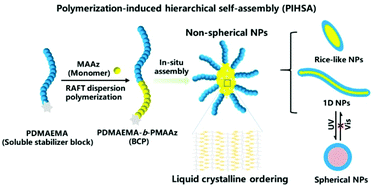Synthesis of azobenzene-containing liquid crystalline block copolymer nanoparticles via polymerization induced hierarchical self-assembly†
Abstract
Polymerization induced hierarchical self-assembly (PIHSA), combining liquid crystallization and polymerization induced self-assembly, is a facile approach to synthesize block copolymer (BCP) nanoparticles (NPs) with non-spherical morphologies. Herein, a PIHSA formulation based on azobenzene-containing poly(N,N-dimethylaminoethyl methacrylate)-b-poly (11-(4-(4-butylphenylazo) phenoxy) undecyl methacrylate) (PDMAEMA-b-PMAAz) BCPs was developed by reversible addition–fragmentation chain-transfer dispersion polymerization in n-butanol at 10% w/w solid content. According to the dispersion polymerization kinetics, a relatively high monomer conversion of ∼95% was achieved within 11.5 h. The morphology evolution was investigated in detail by tuning the chain length of PDMAEMA and feed ratio of MAAz/PDMAEMA. A morphology phase diagram was constructed. Non-spherical morphologies, especially one-dimensional morphologies, occupied a remarkable phase region due to the liquid crystallization of the azobenzene-containing core-forming block. Taking advantage of the photo-isomerization properties of azobenzene moieties, the NPs underwent morphological transformation upon alternate UV/Vis irradiation. This work expands the PIHSA systems and would be helpful for potential applications, such as coating, smart devices, and gene delivery materials.



 Please wait while we load your content...
Please wait while we load your content...